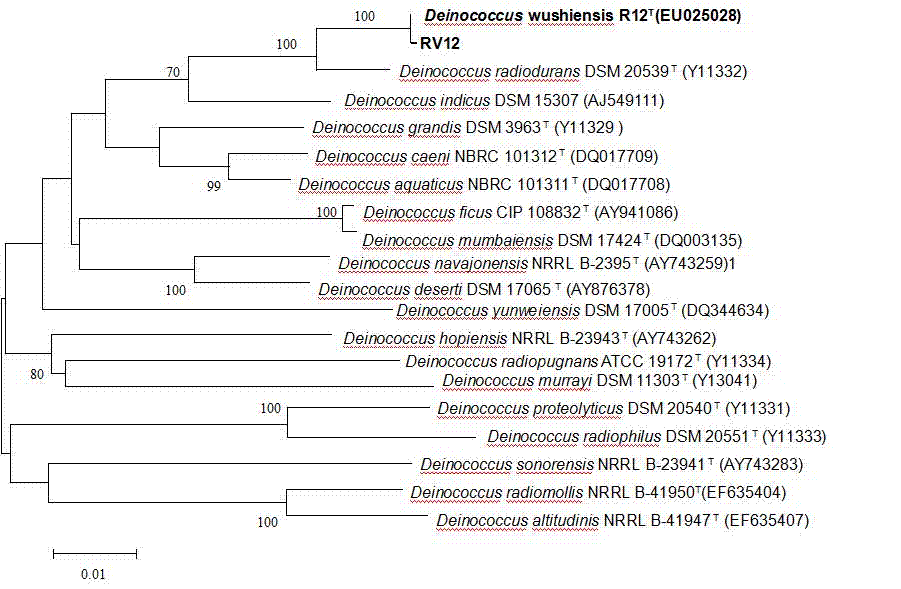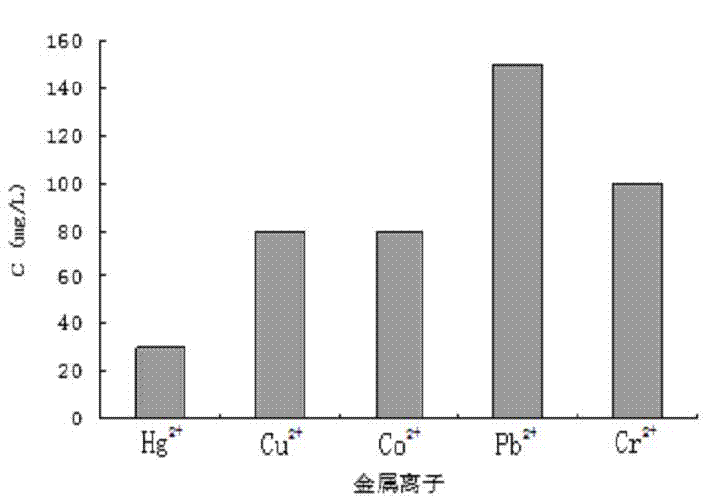Deinococcus wushiensis and application thereof in cobalt ion biological adsorption treatment
An adsorption and application technology, applied in microorganism-based methods, microorganisms, water/sewage treatment, etc., can solve the problems of low removal rate, high operating cost, secondary pollution, etc.
- Summary
- Abstract
- Description
- Claims
- Application Information
AI Technical Summary
Problems solved by technology
Method used
Image
Examples
Embodiment 1
[0021] Embodiment one: Deinococcus urica ( Deinococcus wushiensis ) Screening, classification and identification of RV12 CGMCC No.6675
[0022] A heavy metal-resistant strain RV12 was isolated and screened from a radiation-contaminated environment in an arid desert area in Xinjiang; it was found through morphological, physiological and biochemical identification that its colony was orange-red, small, round, and small after being cultured in TGY medium for 5 days. The edges are neat, the surface is smooth and opaque; the cells are round, in the form of doublets or quadruples; the cells are Gram-positive, non-motile, aerobic, and the optimum growth temperature is 30°C, and the optimum growth pH is 7.0. Sucrose, sorbitol, maltose, mannose, melezitose, xylose, arabinose, rhamnose, dextrin, mannitol, cystine, proline, threonine, tryptophan, tyrosine acid as the only carbon source, the main fatty acid is C16: 1ω7c (53.2%), C16: 0 (20.0%), C16: 1ω9c (6.0%), and the main quinone is...
Embodiment 2
[0024] Embodiment two: Deinococcus urica ( Deinococcus wushiensis ) Liquid culture of RV12 CGMCC No.6675
[0025] The activated bacterial strain Deinococcus uricae of the present invention ( Deinococcus wushiensis) RV12 CGMCC No.6675 was inoculated in a seed test tube containing 5ml of TGY liquid medium, cultured at 30°C, shaken at 200rpm for 36 hours, then inoculated into a TGY liquid fermentation bottle at a 2% inoculation amount, and the amount added was 500ml Bottle 80ml of TGY liquid medium, culture at 30°C, shake at 220rpm for 60h; the surface of TGY medium is 5g of protein, 3g of yeast extract, 2g of glucose, 15g of agar, 1L of distilled water, pH7.5, and culture at 30°C for 48h.
[0026] After the above culture, the maximum concentration of the bacteria can reach 4.51 OD / ml (600nm); the culture is centrifuged at 8000 rpm for 3 minutes, the supernatant is discarded, and the bacteria are collected. The wet weight of the bacteria can reach 5.2g / L.
Embodiment 3
[0027] Embodiment three: Deinococcus urica ( Deinococcus wushiensis ) RV12 CGMCC No.6675 heavy metal resistance
[0028] The activated bacterial strain Deinococcus uricae of the present invention ( Deinococcus wushiensis ) RV12 CGMCC No.6675 was inoculated in a seed test tube containing 5ml of TGY liquid medium, cultured at 30°C, shaken at 200rpm for 36 hours, and then inoculated at 2% inoculum size in different concentrations of Hg 2+ 、Cu 2+ 、Co 2+ , Pb 2+ 、Cr 2+ In the TGY liquid fermentation bottle, add 80ml TGY liquid culture medium in a 500ml triangular flask, cultivate at 30°C, shake at 220rpm for 72h, and observe the growth of the strain; see the attached figure 2 , by attached figure 2 It can be drawn that the application bacterial strain Deinococcus urica ( Deinococcus wushiensis ) RV12 CGMCC No.6675 is resistant to various metals, among which Pb 2+ 、Cr 2+ The maximum tolerated concentration (100mg / L) , Cu 2+ 、Co 2+ Followed by (80mg / L); the surface o...
PUM
| Property | Measurement | Unit |
|---|---|---|
| Adsorption capacity | aaaaa | aaaaa |
Abstract
Description
Claims
Application Information
 Login to View More
Login to View More - R&D
- Intellectual Property
- Life Sciences
- Materials
- Tech Scout
- Unparalleled Data Quality
- Higher Quality Content
- 60% Fewer Hallucinations
Browse by: Latest US Patents, China's latest patents, Technical Efficacy Thesaurus, Application Domain, Technology Topic, Popular Technical Reports.
© 2025 PatSnap. All rights reserved.Legal|Privacy policy|Modern Slavery Act Transparency Statement|Sitemap|About US| Contact US: help@patsnap.com



